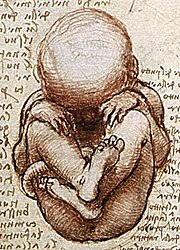
Back حركة الجنين Arabic Movimiento fetal Spanish حرکات جنین Persian תנועות עובר HE 태동 Korean Fosterrörelser Swedish 胎動 Chinese

Fetal movement refers to motion of a fetus caused by its own muscle activity. Locomotor activity begins during the late embryological stage and changes in nature throughout development. Muscles begin to move as soon as they are innervated. These first movements are not reflexive, but arise from self-generated nerve impulses originating in the spinal cord. As the nervous system matures, muscles can move in response to stimuli.[1]
Generally speaking, fetal motility can be classified as either elicited or spontaneous, and spontaneous movements may be triggered by either the spine or the brain. Whether a movement is supraspinally determined can be inferred by comparison to movements of an anencephalic fetus.[2]
This article primarily deals with voluntary and reflex movements. Ages are given as age from fertilization rather than as gestational age.
Some sources contend that there is no voluntary movement until after birth.[3] Other sources say that purposive movement begins months earlier.[4] 3D ultrasound has been used to create motion pictures of fetal movement, which are called "4D ultrasound".[5]
- ^ Vaughan 1996, p. 208.
- ^ De Vries, Johanna et al. "Fetal Motility in the First Half of Pregnancy", in Continuity of Neural Functions from Prenatal to Postnatal Life, pages 4 and 63 (1984 Cambridge University Press, edited by Heinz F. R. Prechtl).
- ^ White, Lois. Foundations Of Maternal & Pediatric Nursing, pages 10 and 128 (2004): "By the end of the 12th week, skeletal muscles begin involuntary movements....The newborn may cry and have muscular activity when cold, but there is no voluntary control of muscular activity."
- ^ Becher, Julie-Claire. "Insights into Early Fetal Development". Archived from the original on 2013-06-01. (Royal College of Physicians of Edinburgh and Royal College of Physicians and Surgeons of Glasgow October 2004): "Purposive movement depends on brain maturation. This begins at about 18 weeks' gestation and progressively replaces reflex movements, which disappear by about 8 months after birth....Reflexes are very different from purposeful voluntary movements which develop during the first year of life."
- ^ Prenatal Image Gallery Index, The Endowment for Human Development (providing numerous 4D ultrasounds that can be viewed online).